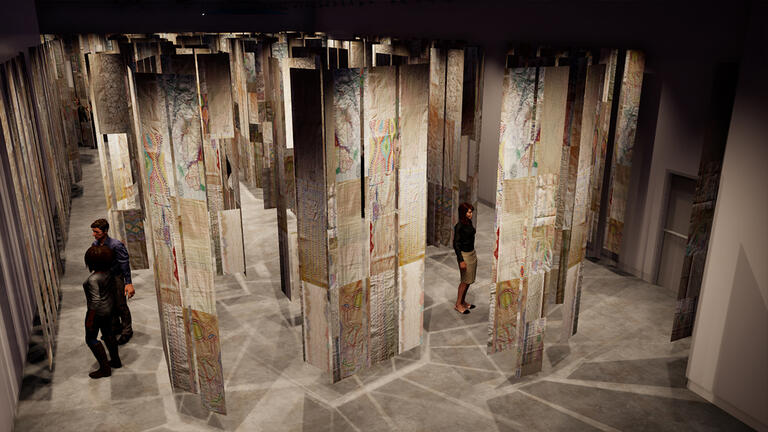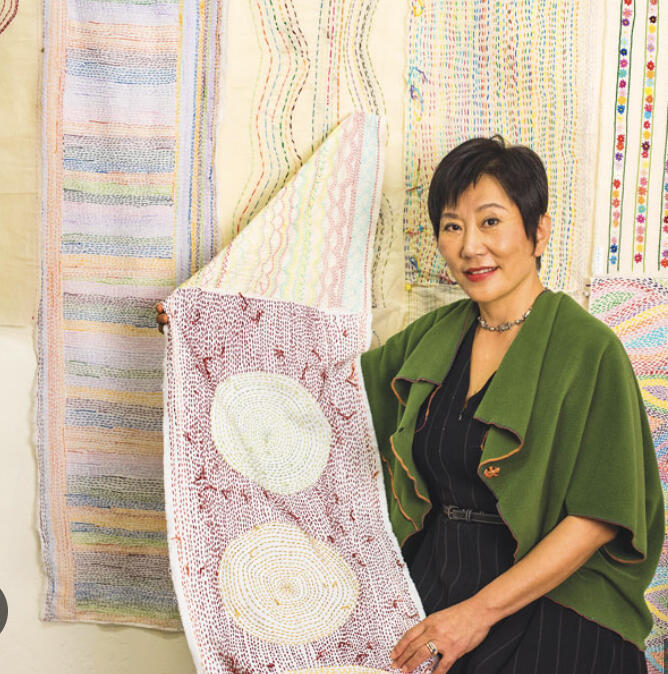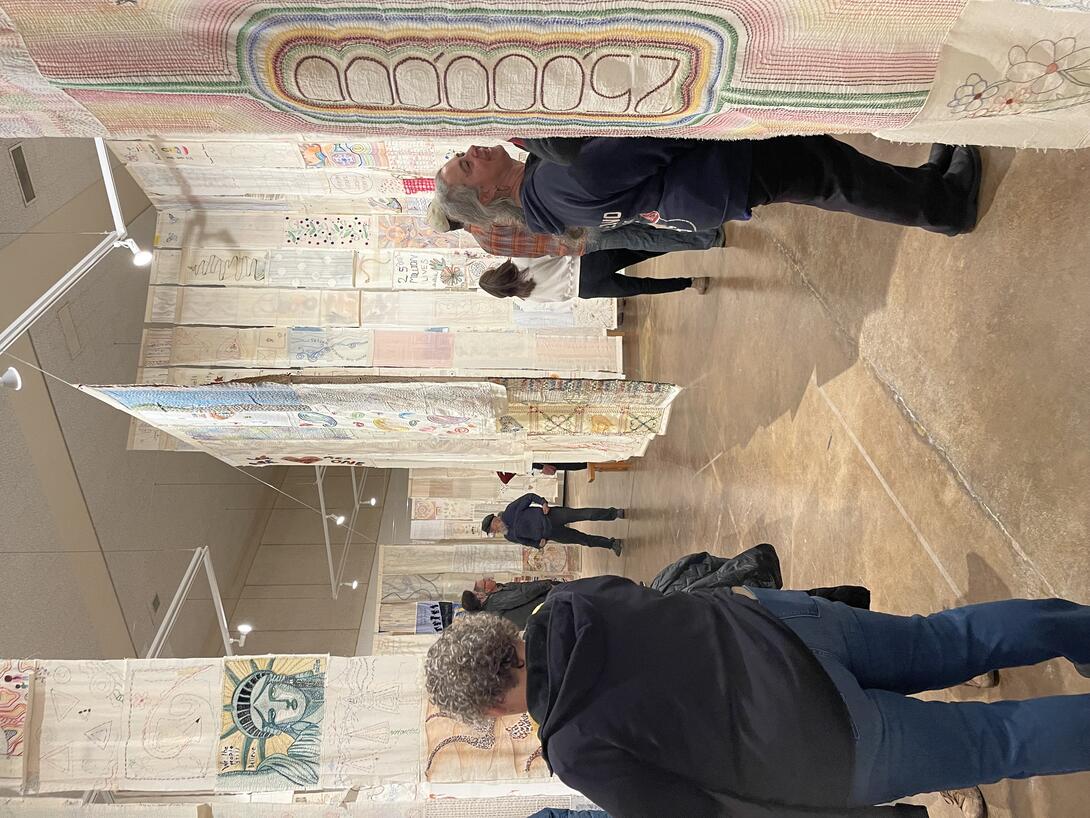Design Alumna Curates 25 Million Stitches: One Stitch, One Refugee


Since 2019, Jennifer Kim Sohn, an alumna of Carnegie Mellon University’s School of Design (BFA ’84), has been curating 25 Million Stitches: One Stitch, One Refugee. This incredible project aims to address the vast crisis of human displacement by making the scale of it more visually relatable through stitches – one stitch for one refugee.
"The inspiration for this project came from two major sources," explained Kim Sohn. "The first was my exposure to data-centered art. I vividly recall the impactful experience of seeing a charcoal rubbing of a small car's exterior surfaces displayed on a gallery wall. I wanted others to share in that moment of realization: the scale of something as common as vehicles, which I had previously taken for granted, was too abstract to comprehend until presented visually.
“In 2013, The New York Times reported on the Syrian refugee crisis, and I began following the heartbreaking stories of children being put on boats by parents, knowing they wouldn’t be able to go with their children,” continued Kim Sohn. “Initially I recoiled at the profound despair of their plight and the magnitude of the crisis, but after sketching daily portraits of refugee children and their parents, I realized that what I could do as an individual was to witness their ordeal and give a voice to the voiceless. That moment touched me profoundly, and was the second critical inspiration for this project.”


Kim Sohn endeavored to learn more about refugee crises from around the world. In 2019, the United Nations High Commissioner for Refugees issued a report stating there were over 25 million refugees worldwide, many of whom were climate refugees.
“Twenty-five million is such an astronomical number, and it’s hard to grasp just how many people that truly is," said Kim Sohn. "I thought like the charcoal rubbings of the car I had observed, my art could make this issue more relatable. I resolved to make the scale of twenty-five million displaced human lives comprehensible by making a mark and repeating it twenty-five million times, viewable in a single exhibit.”
After launching in 2019 in Sacramento, California, the exhibit was able to collect all twenty-five million stitches within one year.
“By choosing basic stitching as the means to tally the number of people displaced, those new to art-activism were drawn to it and became part of our collective mending, of repair,” explained Kim Sohn. “Every participant from 5 to 91 years of age, from the asylum seeker to the artist who had never thought of their art as an expression of social activism, became an essential part of the project.”
Since its completion, 25 Million Stitches: One Stitch, One Refugee has traveled to numerous locations in the United States and has showings booked through 2027 for locations ranging from Arizona to Seattle to Florida.

“I have been moved by the effort and creativity of each and every venue the show has visited to date: how the directors, curators and the museum staff honor the stories that our community of stitchers put together and to amplify the story with outreach programs, concerts, panel discussions to help the museum visitors understand the mission of the project,” said Kim Sohn.
In Flagstaff, AZ, the opening was followed by a choral concert sung in three languages - Arabic, Ukrainian and English. The opening choral piece, “Will you harbor me?,” started with bells ringing amongst the flags of the project’s work and from every pocket of flags the singers emerged to become a river of people and moved to the concert hall. In the Wisconsin exhibit, which is currently open, the museum staff worked with the World Affairs Seminar to have Kim Sohn present art activism as one of the means for voicing the will of people.
Kim Sohn’s hope continues to be that the exhibit transcends political divides.
“Just today I received a note from a viewer who described their experience viewing the shows as spiritual,” said Kim Sohn. “The director of the Wisconsin museum said some visitors described the exhibit as the perfect ‘purple project,’ in that, although it is a theme that can be controversial and divisive, the viewers would spend many hours in contemplation and share how the exhibit helped them to see the refugees with empathy, as fellow humans needing our help and not as displaced ‘others’.
“This project has evolved so far from what my original vision into a more meaningful and impactful project,” continued Kim Sohn. Leading this project has taught me just how powerful art can be in an activist’s toolbox. Once the participants put their stories and parts of themselves in their individual panels, the project morphed from being a visual testimony of the scale of the crisis to a deeply moving persuasion of why we should care about refugees and their plight.“

Thinking back on her time at CMU, Kim Sohn frames it in terms of her own immigrant experience.
“I transferred to CMU in my second year after immigrating to the USA,” said Km Sohn. “So my take on the school was colored by figuring out who I was in this exotic and new country. A lot of my memories were about adaptation, but CMU was an environment that let me do that at a comfortable pace. Had I been more fluent in English, I think I would have been an engineer or a scientist, so perhaps it was a good thing that it took a while for me to be able to articulate myself the way I wanted to.
“The other silver lining of my language handicap was it helped me realize how powerful design is as a communication tool. My experiences in the classroom led me to discover that the greatest power of visual communication was not in the precision and aptness of conveying a thought, but in how subtle and suggestive, yet convincing and visceral, it can be in persuading the viewer.”
Kim Sohn credits her design education at CMU for shaping her career as an artist. She strongly believes that the discipline of seeing herself both as the creator and a viewer of her art has helped her become a more effective visual communicator.
"I believe that being a designer has greatly influenced my work as an artist-activist by giving me the foresight that the process, rather than my original idea or intentions, will complete the piece," said Kim Sohn. "Even when I work on individual projects addressing environmental and social justice issues, I'm no longer only fascinated by the initial idea and plan. I now allow the materials, techniques, and even mistakes to shape the project.
“In the 25 Million Stitches project, once I put a call out to the public to collaborate with me by hand stitching twenty-five million stitches, I knew instinctively to step aside and take the role of a project manager while letting the community be the designer of the project,” continued Kim Sohn. “I think that intuition came from having been a designer and because I trusted in the outcome without knowing where our community would lead the project, the exhibit was able to become powerful, humbling, and able to speak so eloquently about the refugee experience.”
Learn more about 25 Million Stitches: One Stitch, One Refugee.
More info on how to host 25 Million Stitches: One Stitch, One Refugee.
Jennifer Kim Sohn's Portfolio site.